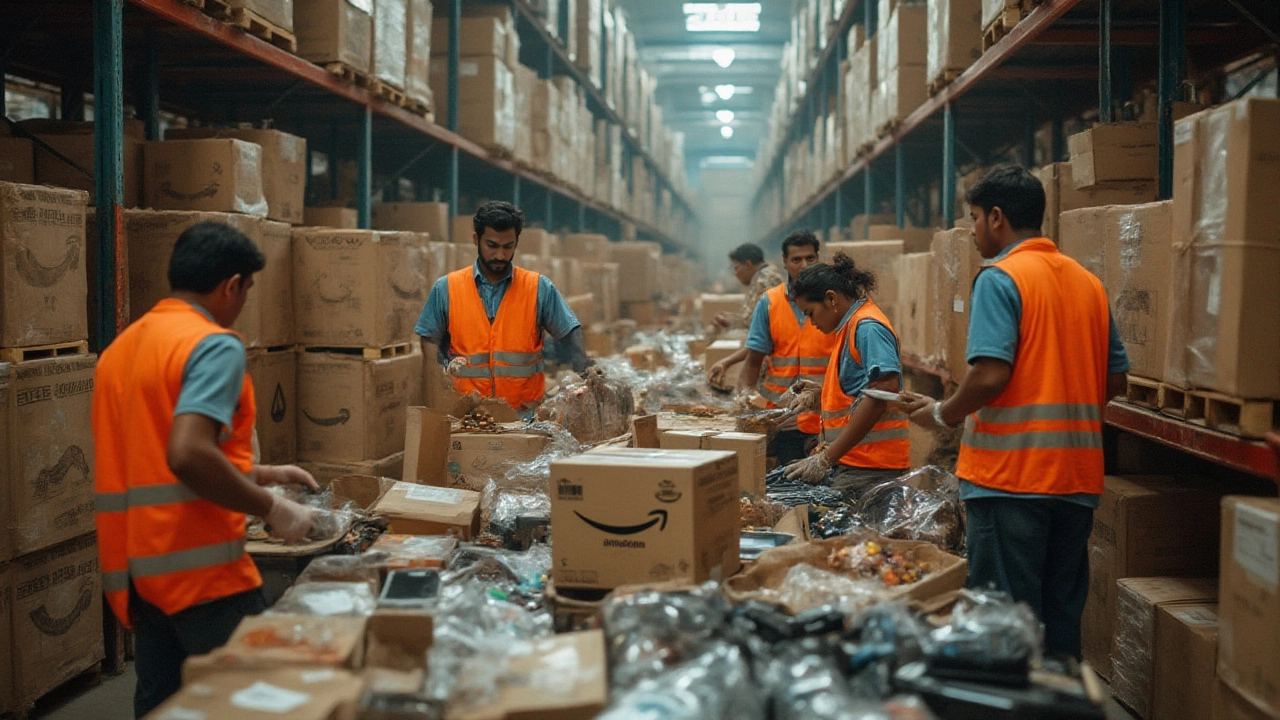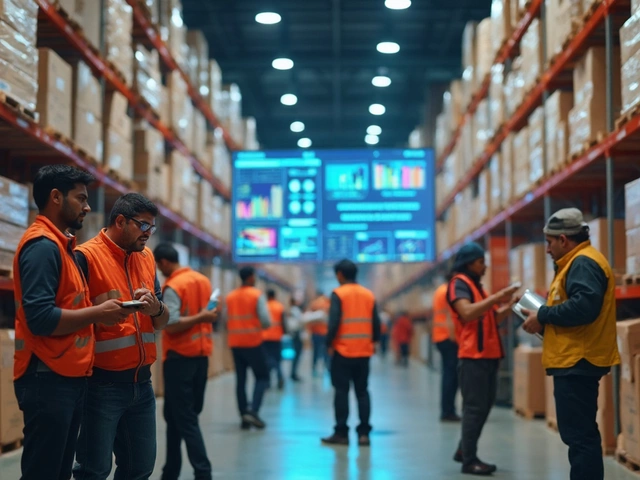It sounds like an urban legend: huge crates loaded with marked-down Amazon goodies, sealed and shipped straight from the e-commerce giant’s returns flow. Videos of people ripping open giant cardboard boxes full of electronics, home goods, and random finds clock millions of views. Some claim instant riches; others reveal laughable failures. But here’s the burning question: is the Amazon pallets hype legit, or are we all getting played?
What Are "Amazon Pallets" and Where Do They Come From?
Let’s not get swept away by TikTok fantasies. The idea of “Amazon pallets” comes from a real problem: returns. The retail industry’s average return rate is now around 16.5% for online purchases, and Amazon moves a mind-blowing number of packages—estimates from 2023 put it at over 7.7 billion parcels shipped globally. When customers send stuff back, Amazon has to do something with it. And no, it’s not all thrown in the trash or “re-furbished”—a lot ends up in liquidation channels. This is where Amazon pallets step in.
To picture it: imagine a warehouse packed ceiling-high with thousands of returned or overstocked items. These aren’t neatly chosen favorites—think of a blender with a dented box, last year’s Bluetooth speaker model, maybe even half a dozen air fryers waiting for a new home. Instead of wasting time and money repackaging and reselling, Amazon bundles everything onto a large wooden skid or a "pallet." The entire pallet, in shrink-wrap straight from the chaos, is sold to liquidators in bulk. Sometimes, the contents are semi-documented, sometimes it’s a “mystery box” gamble.
The pallets’ path doesn’t stop at liquidators. Third-party resellers, side hustlers, or small business owners snap up these bundles, often online via sites like B-Stock, Direct Liquidation, or Liquidation.com. Each of these companies acts as the middleman, listing and auctioning Amazon pallets to the broader public. Sometimes, pallets are even sold locally. Still, the true scale is staggering: In a 2024 industry survey, liquidation sales represented about $644 billion worth of inventory in the U.S. alone, with Amazon as one of the biggest contributors.
So, yes—Amazon pallets are absolutely a real thing. But that doesn’t mean every crate is a goldmine. Some people find expensive gadgets or brand-name products, others get piles of outdated tech and broken humidifiers. The whole scene is driven by the constant churn of e-commerce returns and the need for retailers to cut storage costs and salvage value wherever possible.
How People Buy Amazon Pallets and What’s Inside
So, how do regular folks actually get their hands on one of these mystery treasure chests? There’s no secret handshake. Most buying happens through online liquidation platforms that work directly with Amazon and big-box retailers. Here’s a quick breakdown on how it works:
- Find a verified liquidation marketplace (e.g., B-Stock, Liquidation.com, Direct Liquidation, and sometimes local classified ads).
- Register as a buyer, sometimes with business credentials (but not always necessary).
- Search for Amazon pallets (they could be labeled as “Amazon returns,” “Amazon shelf pulls,” or “warehouse surplus”).
- Check the manifest if there is one. Some shipments list every item, condition, and MSRP; others just give general categories like “electronics” or “home goods.”
- Bid on or buy the pallet. Prices vary massively—anywhere from $150 up to several thousand dollars, depending on the size, contents, and shipping distance.
- Arrange transportation. These pallets are heavy—expect hundreds of pounds, and freight costs quickly add up.
- Crack open your haul, sort, test, repair, and resell—or just keep the gems you find.
People love to share stories about their finds. Lisa Powers in Ohio snagged a pallet and found $400 worth of new kitchen gadgets for $230. Diego Torres in Texas bid on an electronics pallet and landed a stack of phone cases, plus an iPad that worked after some cleaning. There’s always risk—you might get a box loaded with defective goods or last season’s unsellable leftovers.
Here’s a table showing what’s typically found in Amazon return pallets, based on a 2024 sampling by the National Retail Federation:
| Category | Typical Percentage of Pallet | Resale Potential |
|---|---|---|
| Electronics | 15-20% | High (if working, but returns often have defects) |
| Home & Kitchen | 25-35% | Medium to High |
| Toys & Games | 5-10% | Seasonal boom, variable otherwise |
| Clothing & Footwear | 10-15% | Volume, but sizing/seasonality issues |
| Health & Beauty | 5-10% | Strict resale rules, mixed demand |
| Miscellaneous | 10-20% | Surprises galore—could be great, could be a bust |
Some sellers buy by the truckload and make a full-time living off this. But even casual buyers can score discounted goods for themselves or side hustles. Be warned, though: reselling is work. Testing products, photographing items, writing listings, shipping—there’s no such thing as easy, instant profit, despite what TikTok tells you.

The Pros, Cons, and Real Risks of Amazon Pallets
It’s easy to see why liquidation caught fire. Everyone wants a cheap deal or the thrill of a lucky find. But you need to go in with your eyes open—or risk burning your budget instead of building a business. Here’s what people aren’t always upfront about:
- Amazon pallets are not curated. They often contain a random mix, sometimes with duds or damaged goods, especially with mystery boxes.
- Shipping is expensive and can eat into any profit you hoped for. If you’re not local to a warehouse, trucking costs can be a deal breaker for individuals.
- Returns are final—liquidators don’t take complaints or accept returns. It’s "as is."
- Time and labor add up fast. Sorting, cleaning, fixing broken items, testing electronics—it’s not a five-minute project.
- Value varies wildly. You might score $1,200 in retail value, but if most is outdated tech or unsellable, real-world returns drop fast.
- Not every state allows resale of certain items, especially cosmetics or recalled goods. You need to check your local regulations.
- Scammers lurk in this space too. Stick to liquidation sites with good reputations and read forum reviews.
Still, people do make money flipping liquidation finds. One couple in Florida made $23,000 in six months reselling Amazon pallet items online and at local flea markets—primarily by hustling, learning from losses, and treating it as a business, not a lottery ticket. Most successful buyers track every dollar and only buy manifests that fit their niche (like tools, or kitchenware). Seasoned resellers are also quick to sell off duds in bulk or bundle damaged packaging for quick recovery. There’s a whole subculture, complete with YouTube “unboxings” and eBay how-to guides.
What about the thrill factor? Yes, half the fun is unwrapping your haul—not knowing if you just landed something epic or a stack of obsolete router cables. And if you treat it as part-hobby, part-challenge, the risk can feel worth it, especially for die-hard bargain hunters. But for anyone dreaming of easy money, the potential for disappointment is real.
Tips for Getting the Best Value with Amazon Pallets
If you’re thinking of buying your first Amazon return pallet, a few battle-tested tips can make all the difference. Here’s what seasoned resellers suggest (and wish they’d known on day one):
- Always request a manifest. Even partial manifests are better than total mystery. They let you estimate value and filter out the worst duds.
- Start small. Don’t jump into a truckload unless you know what you’re doing—test the waters with one pallet first.
- Factor in shipping. Freight can add hundreds, so search for local pickup options or team up with other buyers to split delivery costs.
- Research reselling rules. Some items (e.g., beauty products) have age or licensing restrictions on eBay, Facebook Marketplace, or Amazon itself.
- Count your costs. Don’t ignore tests, repairs, storage, or packaging for resale; factor that into your profit calculation.
- Double-check seller credentials. Real liquidation companies don’t reach out with random DMs or promise Amazon “exclusive” pallets for pennies—avoid any site with spotty contact info or no real reviews.
- Network with others. There are Facebook groups and Reddit threads where buyers share results, alert others to scams, and even do trades.
Looking for the best time to buy? Some resellers swear by post-holiday periods, when returns spike and warehouses overflow with inventory (think January and August for back-to-school). Summer is sometimes slower, but that means less competition bidding for pallets.
If you’re only in it for yourself—not to start a resale empire—look for local auctions and estate sales. Sometimes, schools, surplus resellers, or community sites like Liquidation Nation run regional pallet sales without cross-country shipping fees. And if you get burned with a dud? Don’t give up—some people make back losses in three or four flips, thanks to a single great find later.
So, if you go in prepared (and embrace the chaos), Amazon pallets can be a real bargain-hunter’s adventure. It’s not a fairy tale—there’s risk, hustle, and the occasional lopsided haul. But that’s also what keeps people coming back for more crates and more surprises.





